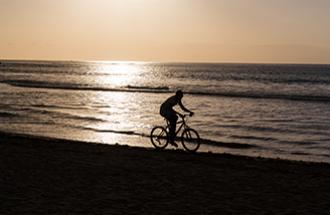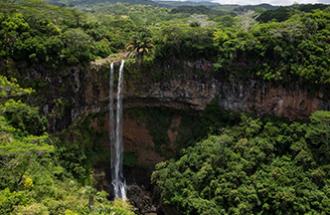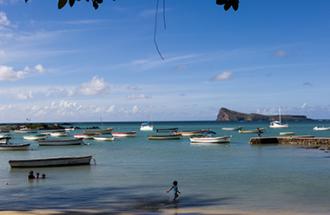Inland & Center
Inland & Center
Time to leave the usual beaches and try a few excursions inland to get a feel for the heart of the island. Cooler than the coastal regions, the central plateau is situated between 400 and 600 meters above sea level. Starting from the South of Port Louis, this vast urban area is home to about 400,000 people, representing over one-third of the island's population. High up on the plateau, you’ll also find forests, lakes and plantations that are well worth a visit.
What to See?
Towns
Four towns, namely Rose Hill, Quatre Bornes, Vacoas and Curepipe, make up the heart of the island.
Rose Hill’s busy high street is swarming with shoppers during the day and is worth a visit if you’re ready to brave the crowds and look for some great bargains. There are many shops to browse and local restaurants to choose from.
Quatre Bornes is a cosmopolitan town, where you will be able to barter for great deals at its famous market. The shops on the main road are also a good place to go bargain hunting!
The town of Vacoas is best known for the Gymkhana Golf Club, the oldest golf course in the southern hemisphere. Locals run and walk around the outdoor track for exercise and play football in the grounds.
Finally, Curepipe, where you’ll experience the coolest temperatures in Mauritius, has retained its charm and is home to two of the island’s treasures: Trou aux Cerfs, the crater of a dormant volcano, and the Botanical Garden with its rare plant species.
Trou aux Cerfs
The most famous dormant volcano in Mauritius. From there, you have a fantastic 360° view of the high plateau of the Island of Mauritius. Local joggers meet every day at 5am at Trou aux Cerfs.
Ganga Talao
Not far from Mare aux Vacoas reservoir is Grand Bassin, also known as Ganga Talao. It is one of the rare natural lakes in Mauritius, formed inside the crater of an extinct volcano and is the renowned pilgrimage place for Mauritians of Hindu faith. Every year in February, during the Maha Shivaratri week, thousands of Hindus walk miles from every corner of the island to bring their gifts for Lord Shiva at Grand Bassin.
Eureka "La Maison Créole", Moka
This historical mansion built in 1830 with no less than 109 doors will provide you with a glimpse into the lifestyle of the more affluent Mauritians during the colonial era. The Eureka House Restaurant also offers Creole meals that will delight the finest palates.
The Folk Museum of Indian Immigration
Mahatma Gandhi Institute
This museum evokes the influx of coolies who came to work as labourers after the abolition of slavery in Mauritius in 1835.
Working for a pittance, they gave a new impetus to a non-competitive sugar industry. In 1909, at the end of the Indian immigration, they were 450,000.
Today their descendants account for two-thirds of the Mauritian population. This well-documented folk museum shows in detail the daily life of Indian workers during the nineteenth century.
Curepipe Botanical Garden
The Botanical Garden in Curepipe were created in 1870 and are the second largest botanical garden in Mauritius. The garden is home to some rare trees and other indigenous plants. You’ll find locals fishing in the river that runs through the gardens and there is a lake surrounded by Nandia palms.
A walkway runs through the gardens where you’ll find families and children playing and running, and couples walking hand-in-hand. The gardens are where the famous Mauritian writer and painter Malcolm de Chazal saw an azalea flower “looking at him” and so began his famous writings, which he later published in his book “Sens plastique” in 1947.
Balfour Garden
A garden and playground in the quiet suburbs of Beau Bassin, a sister town to Rose Hill, is where locals come to exercise, children play and couples and families picnic. Take a walk, through the pretty, tranquil gardens and appreciate the fresh air and quiet setting. Beautiful views of a waterfall, the Grand River North West flowing towards Port Louis, and the stunning Moka Mountain range in the background add to the charm of these gardens.
Things to do
Eating out
A number of authentic Chinese-Mauritian restaurants will be found on all the high streets and traditional Indian food sold by hawkers can be found on just about every roadside or in the markets. Look for the longest queue and you’ll be sure that the food at the end of it is good!
Climbing the moka mountain range
Looking like a ‘thumbs up’, at 811 metres Le Pouce mountain is the third highest mountain in Mauritius and forms part of the Moka Mountain Range. Close to Le Pouce is the 820 metres high Pieter Both with its distinctive stone ball that appears to balance right on the top. You can hike up these mountains from both Saint Pierre and Port Louis, but always check on the weather conditions beforehand and plan accordingly, or if you prefer to be accompanied by a guide, book through an adventure company. From the top, you are able to see most of the island, so it goes without saying that the view is incredible!
Follow the Tea Route
The "Tea Route" is a must when you visit Mauritius. A treat for the senses, this aromatic journey through the world of tea starts at Domaine des Aubineaux, takes you to the factory of Bois Cheri at Rivière des Anguilles and finishes at Domaine Saint Aubin.
Institut Français de Maurice
The French Institute (formerly the Charles Baudelaire Cultural Centre) situated behind the Rose-Hill Police Station is the place for cultural activities with both Mauritian and invited foreign artists. The Institute has a vast library, an office that offers guidance to students who want to study abroad, and a restaurant on site. Their program can be viewed online.
Plateau Route
Plaine Champagne
At 600 metres, Plaine Champagne is the highest plateau in Mauritius and is covered with forests and lakes. Travel by car from Vacoas or Curepipe towards Mare aux Vacoas, the main water reservoir in Mauritius, and visit the sacred Grand Bassin along the way. At Pétrin you can hike in the Macchabée Forest past the Mare aux Joncs waterfall and walk around the Mare Longue reservoir back to Pétrin. If you want to walk further and have someone to drive your car, you can walk down into the Gorges and meet your driver in Black River. You can also cycle along these same trails.
If that all sounds a bit too adventurous for you, head to the nature reserve at Bassin Blanc, or take a right and stop at the different viewpoints along the roadside. Appreciate the fresh air, the stunning views of the South and the East, and you may even spot some wild monkeys. In March and April, you can stop and pick the delicious red and yellow guavas from the bushes that border the road.
The Plaines Champagne route will also take you to Chamarel, the seven-coloured earth, and to Le Morne.
Rum Factory
La Rhumerie de Chamarel distils rum from its own sugar cane planted in fields nearby. Visit the impressive copper vats used to make the delicious rum and different rum liqueurs. The on-site tasting will help you to discover your favourites, which can then be purchased directly from the distillery. There is a restaurant on site serving stunning meals in a truly beautiful location. Why not try one of their exotic rum cocktails to end the day?
Restaurants in Chamarel
In Chamarel Village, there are plenty of small family restaurants where you can stop and sample the delicious local fare.
Seven Waterfalls
Fancy hiking and canyoning down the seven waterfalls? To be safe, it's best to go accompanied by a professional guide who will make sure you have lots of fun among flora, fauna and the wildlife, with unbelievable scenery to boot.
Shopping
There are many clothing and textile manufacturers in Mauritius who produce for the local and international market. Prices are competitive and quality is of a high standard. There are colours, styles and brands for all ages and sizes. As well as clothing you can buy electronics, jewellery, popular wines and whiskies, shoes, accessories, arts and crafts, paintings, books… the list is endless! Shop ‘til you drop in Mauritius!




